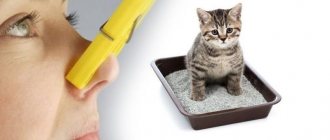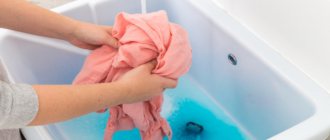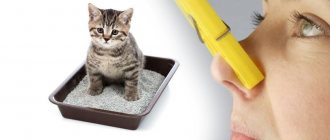Cats are capable of bringing a lot of positive emotions to their owners with their cozy purring, devotion and good disposition, but there is one “but” - they are neutralized by the animal’s instinct to mark its territory, leaving stinking puddles on the fluffy parquet carpet, on clothes and shoes. The smell of cat “marks” is extremely difficult to get rid of. The fact is that it is impossible to get rid of it with ordinary detergents, even the most expensive and advertised ones; you need heavy artillery - a mix of folk recipes and chemicals. When used correctly, they give excellent results, especially if they are supplemented with psychotherapy sessions for the pet - strict scaring with weaning, as well as castration and sterilization. Drastic methods will rid your home of stinking puddles and marks, but they are only suitable for those who are satisfied with an docile and calm companion, into whom your tailed bully will turn after the operation.
Causes of odor
The smell emitted by cat urine is unusually persistent. Why does my cat's urine stink? The reason is the specific composition of this liquid:
- urochrome – coloring matter;
- urea, which gives a sticky consistency;
- uric acid, which accelerates the process of crystallization of secretions.
An unpleasant odor appears when urea decomposes with the help of bacteria. Decomposition products (thiols) smell even worse. When you try to use traditional detergents to remove "fragrance", only superficial traces are removed. Urine crystals are insoluble in water, so they remain on the surface and after a while the smell appears again.
Tips for removing cat urine odor
global $ads_google;
//data-ad-slot=”2475549904″ $ads_google = empty($ads_google) ? false : true; ?> if ($ads_google == false) {?> $ads_google = true; ?> } ?> When you discover the source of the odor, the first thing to do is to blot the puddle with a paper napkin. Do not allow urine to dry out. If urea and urochrome are highly soluble in water, then uric acid crystals can only be removed with alkali, glycerin or sulfuric acid.
Remove odors using bleach, if the surface allows. You should not use ammonia for this purpose because of the ammonia content - the same component is found in the urine of cats, which can provoke the pet to repeat the experience.
In order to remove the smell of cat urine , chemicals and folk methods that have been proven effective are used. Don't despair, we'll eliminate the smell!
Traditional methods of eliminating traces of urine
How to remove and neutralize the smell of a kitten at home? Over the centuries of coexistence between people and domestic cats, many ways have been invented to combat the unpleasant consequences of cat marks. Some of the remedies are quite radical and can change the color or texture of the furniture instead of destroying (eliminating) traces of ugliness. Therefore, before using it in an apartment, it is better to test the substance on the least visible area of the surface to be cleaned.
Potassium permanganate solution (potassium permanganate)
A solution of potassium permanganate reacts with ammonia molecules. The stench disappears, but the surface turns pink. The water-repellent coating must be immediately washed with clean water to remove excess potassium permanganate. If the surface absorbs moisture, the color will remain forever. When preparing a solution for removal, you must thoroughly stir the liquid to dissolve the raspberry crystals.
Vinegar
Prepare a solution of vinegar and water in a ratio of 1:2 and spray from a spray bottle onto problem areas. After such treatment, the surface should be washed, and the clothes should be washed and sent to the wash.
Lemon juice
Mix the juice of half the fruit with 100 ml of water and pour into a fragrant corner. It is not recommended to wash off, since the strong aroma of citrus fruits will not allow the cat to leave marks in the same place again.
Soda with hydrogen peroxide
This method has worked well for removing urine stains from carpets and upholstered furniture. Sprinkle a thick layer of baking soda powder onto the stain and pour in peroxide. Leave the mixture for 12 hours, then remove the remaining mixture with a cloth soaked in soapy water.
You can do it differently: mix 15 g of peroxide, 2 tbsp. l. soda powder and pour into a bottle with soap solution. Pour the mixture onto the stain, then rinse.
Iodine
Dilute 10 drops of iodine in 2 glasses of water. Wet the stain with the mixture, wait 3 hours, then rinse. This method is not suitable for light-colored coatings, since iodine has a coloring property.
Glycerin soap
To remove dirt from furniture upholstery, carefully treat the stained area with a moistened bar of soap. Then you should go over the dirt with a stiff brush, rinse and dry.
Laundry soap
Grate a bar of soap, add heated water, and stir. When the composition becomes homogeneous, rub the mixture into the marked area, wait half an hour and rinse with warm water.
Vodka
Trying to remove a urine stain or smell with vodka is useless. You can only discourage the cat from using this place as a toilet again, since alcohol stinks and cats can smell it a mile away. Other residents will also have to put up with the annoying aroma.
Soda plus salt
This method is recommended for cleaning rugs or sleeping areas. The stained area of the cat's mark is filled with soda and sprinkled with a layer of salt. Leave for 3-4 hours, then rinse thoroughly with warm water.
All of the above methods are suitable for eliminating fresh contamination. To eliminate old traces of cat litter, you will have to use a combination of these products or take the item to the dry cleaner.
The right litter box and cat psychology
Photo from the site: Ozon.ru
For the most part, those people who live in the same house with cats get so used to the pungent musky smell that they even stop feeling it completely, but those who enter the apartment for the first time have to wrinkle their noses in displeasure. However, there is no need to think that it is better to completely abandon such a pet, since cats can be extremely careful when they are happy with everything. Then you won’t have to think about how to get rid of cat smell. If the animal is well brought up, fed on time, healthy, and has an excellent relationship with its owner, then no problems should arise, but when this does not work out, you should first find the reason, what the animal is protesting against or what it is hinting at.
Need to know
If you have to find out how to remove cat smell from a house or apartment, this means only one thing - your pet has found real reasons to shit outside the litter box. There can be quite a lot of them, from ordinary household grievances to incorrectly selected litter or an inconvenient location of the cat litter itself. Until you find out and eliminate them, you will have to constantly run around with a rag and it is not at all a fact that you will be able to completely remove the persistent aroma.
But first, you should think about the correct selection of the tray, as well as the filler for it, because this may be the main incentive for the pet to refuse to comply with norms and decency. If you can’t guess with this factor, then you’ll definitely have to think about how to get rid of the cat smell in the apartment. Vivid impressions are guaranteed to you, but no one guarantees that they will be pleasant. So how to choose the right tray itself and what is the secret?
- The tray should be large and deep enough for the cat to comfortably climb into it completely.
- There should be a lot of filler in the box; it must be in a thick layer so that the cat can easily dig a hole.
- Purchasing a tray with a grid will eliminate the problem of animals scattering litter throughout the room, but not all cats agree to such options, because rowing is an instinct, be prepared for scratched walls, rugs and slippers neatly pulled into the cat litter box.
- In order not to worry regularly about how to get rid of the smell of cat litter, the tray should be washed quite often under running water, and it is quite acceptable to use detergents that do not have a strong aroma, or ordinary bleach. This smell attracts cats, the main thing is to rinse the dish well after cleaning, the pet will unmistakably recognize the aroma.
Photo from the site: FeelIt.ru
It doesn’t hurt to immediately decide on the correct filler so you don’t have to worry about how to remove the cat smell. It is likely that if you guess wrong, your cat will shit in the corners. There are a huge number of options, fortunately, pet stores now sell fillers by weight, so you can try everything before settling on one thing. In order to no longer worry about how to remove cat smell from an apartment, you should choose a substance that absorbs aromas; you really need to take this moment seriously.
Professional odor neutralizers
If it is not possible to remove the cat’s waste using a homemade method, you will have to use professional odor eliminators. The modern chemical industry produces a large list of products designed to completely eliminate unpleasant odors.
Shredder “8 in 1 NM advanced”
An effective product for removing old stains, including vomit, grass, urine and blood stains. Active oxygen and bio-enzymes included in the product guarantee complete cleaning and remove odors. The destroyer is recommended for use on carpets, cat litter boxes, soft and hard surfaces, and fabrics.
Dezosan
The composition, working at the molecular level, is designed to completely eliminate unpleasant odors. Recommended for use in washing vacuum cleaners.
Odor kill
After using this vanilla-smelling product, the aromas of burning, smoke, fur and pet feces will completely disappear from the air. Method of application: the drug is dissolved in water and sequential treatment of all coatings in the room, both hard and fleecy, is carried out. Per 100 sq. m. surface will need 1 liter of product.
Odor Gone
The herbal drug is produced at Russian enterprises under an American patent. Advantages:
- natural composition;
- disinfecting properties;
- no allergic effect;
- economical (up to 10 sprays of spray per room).
Thornell Cat Odor -off
After spraying the remover, the smell of urine and feces is completely eliminated, quickly replaced by a fresh aroma. The product can be applied to any coating.
Urine -off
Designed to completely neutralize uric acid crystals that cause unpleasant odors. The reaction products are completely harmless: water and carbon dioxide. The drug stabilizer also serves to block cat pheromones. This quality makes it possible to exclude that the cat will want to mark the treated area again. Urine-off does not contain allergens or toxic chemicals and is recommended for areas where small children live and in cars.
Boric acid
The smell of cat urine can be removed with boric acid or regular carbonated water.
- Remove excess urine with paper towels. Dilute boric acid with water and treat the stain. Then cover the stain with baking soda. A chemical oxidation reaction will occur and the smell of urine will disappear.
After the stain has dried, remove the remaining soda using a vacuum cleaner and wash the treated surface with water.
The same effect can be achieved by using regular sparkling water. The sequence of actions is similar to the previous method.
Chemical method of urine decomposition
How to remove and decompose cat urine at a chemical level? To eliminate foul-smelling traces of a cat's activity, you can use a recipe designed to remove the stench of skunk excretions. The urine of these animals contains protein compounds that serve as a source of discomfort for others. The process involves two stages: removal of uric acid, and then neutralization of thiols. Required ingredients: nine percent vinegar, soda, hydrogen peroxide and dishwashing liquid.
Procedure:
- 1) Remove moisture using paper napkins or cat litter.
- 2) Dilute vinegar with water in a ratio of 1:3. Pour the solution over the treated area and leave to dry. At this stage, urine is destroyed.
- 3) After the vinegar has completely evaporated, lightly sprinkle the stain with baking soda powder and immediately proceed to the next step.
- 4) Combine hydrogen peroxide with an equal amount of water, add a teaspoon of liquid dish soap. Spray the mixture over a surface sprinkled with baking soda until foam appears. Wait for the reaction results (2-3 hours). The chemical reaction serves to produce oxygen, which neutralizes the thiols. Liquid soap is used to create foam that traps oxygen in the dirty area.
- 5) Remove dry mixture residues using a vacuum cleaner.
Using this method to eliminate odor is not only effective, but also does not require large expenses, since all components are inexpensive. The method can be widely used for cleaning entrances, elevators and other public areas. To remove old, stubborn dirt, pre-treatment with enzymes is recommended. A day after cleaning, you should treat the stain with vinegar, and another day later - with a mixture of soda and peroxide.
The vinegar in the recipe can be replaced with ethyl or isopropyl alcohol, but these substances are very toxic and can cause serious poisoning.
Modern remedies for the smell of cat urine
The smell of cat urine can be removed using imported or domestic special products. Effective ones necessarily contain enzymes that can easily cope with the neutralization of uric acid crystals.
You can choose a product that is suitable for a specific damaged surface. The label always contains detailed instructions for use, which are important to follow strictly. Otherwise, the effect will be far from expected.
The cost of such funds justifies the result.
How do people remove the smell of cat urine?
Popular experts have tried a thousand and one remedies. All tips are based on strong-smelling essential and natural aromas. There is no need to experiment; above there is an explanation of the reasons for the pungent, long-lasting smell of cats’ urine: no amount of coffee, parsley, mint, or aromatic oils can cleanse the fouled area of the pungent odor. But it’s easy to attract the cat’s attention and push him to a new “feat”.
People-proven remedies include lemon juice or powdered citric acid, table vinegar, potassium permanganate, 3% hydrogen peroxide, iodine solution, and vodka.
You can add glycerin and potassium permanganate to the water: after soaking the urine in paper, all that remains is to properly treat the surface area with the mixture. In this case, potassium permanganate deodorizes the area and serves as an oxidizing agent. The product is not used on furniture, carpets or shoes due to the color of the substance.
Hydrogen peroxide should not be used on colored fabrics - the smell will be eliminated and the color will be easy to get rid of.
Cleaning various surfaces
In order not to spoil the material during cleaning, before using the cleaning composition, you need to check the reaction on a small area of the coating.
Sofas, armchairs
For fabric coverings, the best solution would be potassium permanganate (for dark colors), vinegar solution or lemon juice.
Laminate, linoleum, parquet
Wipe the surface with a solution of vinegar or lemon juice, leaving the floor damp. After an hour, you can remove any remaining moisture by wiping the floor dry.
Bed
It is recommended to remove stains from mattresses, blankets and bed linen using sparkling water and salt. After pouring water and adding a layer of salt, wait 2-3 hours, then wash off the residue.
Shoes, sneakers
Is it possible to wash cat piss off shoes? Tags on shoes are the most difficult to remove. If the marks are fresh, you should try to get rid of moisture by placing napkins or newspaper inside the shoes, and then wash the shoes with laundry soap.
If the mark has already become old, it is recommended to repeat the washing procedure several times, and then wipe the shoes with a vinegar solution. Fabric shoes can be washed in a washing machine. If your boots continue to smell unpleasant, it is better to buy an odor neutralizer from a pet pharmacy.
Carpet
The general rule that a fresh tag is easier to remove also applies in this case. You can use a solution of vinegar, lemon juice or laundry soap. It is recommended to pour vinegar over old stains and cover them with baking soda powder.
Cloth
It is better to simply wash and rinse soiled clothes, jackets, and stains in a weak vinegar solution.
Wooden furniture
Cover the stain with an even layer of baking soda. Wait 40 minutes, then remove the residue and spread the surface with laundry soap. To enhance the effect, the soap must first be grated and soaked.
House plants
Plants are treated by watering. Add an activated carbon tablet to 1 liter of water.
Precautionary measures
Frequent use of cleaning liquids containing chlorine can negatively affect the well-being of people and animals.
Vinegar and lemon solutions greatly dry out the surfaces being treated. After such treatment, the leather may crack and dry out, so it is recommended to use special products for the care of shoes or leather upholstery.
Coatings with a large number of pores (wood, concrete) require repeated treatment and pre-soaking with vinegar solution. During major repairs, it is recommended to burn the concrete floors using a blowtorch.
Fabrics that have been cleaned with peroxide should be washed with the addition of 100-150 ml of apple cider vinegar.
Manganese or iodine
In order to eliminate the smell of cat urine from clothes, sofas, and carpets, you can use both iodine and potassium permanganate. These substances have a coloring effect, so light-colored clothing, carpeting and furniture upholstery cannot be treated with them.
Initially, it is necessary to remove excess cat urine on the fabric surface. Blot fresh stains with toilet paper, a paper towel, or an absorbent cloth.
- Prepare a weak solution of potassium permanganate and treat the stain with it. Wait until the stain dries and then repeat the procedure. You will have to do several treatments; this method of removing odors takes time.
- To prepare an iodine solution, dilute 30 drops of iodine in one and a half liters of water. Further actions are similar to the previous method.
Common Misconceptions
One of the common mistakes that owners of furry pets make is punishment without clarifying the circumstances. A cat may mark territory for the following reasons:
- stressful state;
- urinary system disease;
- tail injury;
- uncomfortable tray;
- poor selection of toilet filler.
The second most common mistake is the decision to postpone cleaning until a more favorable time. A fresh stain is much easier to remove, but old urine residue will attract the cat to repeat the violation again.
The third misconception is related to the second and is to get rid of the smell at any cost. The use of deodorants and fragrances (coffee, aromatic oils, incense) relieves the human nose from suffering, but the cat will still feel its marks and will get used to using the marked area of the home space for the toilet.
Chlorine-based products disinfect well, but the stench only intensifies after such cleaning.
Prevention
Prevention methods:
- Sift the litter twice a day, remove excrement on time, and wash the tray with special products once every two weeks.
- If you don't use litter, clean your cat's litter box every day.
- If there are several cats living in an apartment, you must provide a litter box for each of them. As a last resort, buy one large tray for two animals, and also have a spare one.
- Choose a litter for your pet based on its preferences. Some cats prefer wood litter, others clay, and still others clumping. Silica gel is considered the most hygienic, but it is not suitable for all cats. Some animals start eating it, others refuse to go into the tray because the sharp edges of the granules hurt their sensitive paws.
- To prevent your cat from using your shoes as a toilet, treat the soles with alcohol. Store shoes, sneakers and boots in closed drawers or special cabinets.
Tips for renovation
The presence of pets in the home imposes additional obligations on owners. Compliance with a number of requirements when renovating a home will help the animal owner to significantly simplify the life of himself and his charges.
When arranging the floor, fleecy coverings should be avoided. It is impossible to properly clean such surfaces, so the carpet floor will always serve as a source of dirt and infection.
Laminate looks no worse than parquet, but urine easily gets into the holes between the boards, promoting rot. Wooden or varnished parquet floors are much more hygienic.
When laying baseboards, you should carefully seal the joints, leaving no holes between the floor and walls. It is recommended to lay an insulating film on top of concrete floors to prevent the concrete from getting wet.
When choosing linoleum, you should give preference to a material with a waterproof synthetic lining.
Tile or ceramic tiles should only be attached with an adhesive base. Using the solution creates cavities into which urine can leak through the seams between the tiles. For high-quality sealing of seams, you need to use a polymer-based grout to protect against corrosion by uric acid.
The best choice for a home with cats and dogs would be epoxy self-leveling floors.
Cleaning the house will be greatly facilitated if the lower part of the walls is painted with paints that can be washed using brushes and chemicals. It is not recommended to use paper and fabric wallpaper. The plaster should also be checked for acid resistance before installation.
For cleaning, it is recommended to use a water vacuum cleaner.
How to “fight” a cat that is marking
It is easier to take preventative measures than to eliminate the consequences of cat “accidents”. The following recommendations are relevant for owners whose pets have already begun to mark their territory, and for those who have not yet comprehended this experience. Working warning actions:
- Treat the problem area with vodka - it will not get rid of the stain, but the smell will scare off the cat for a long time.
- Leave lemon or orange slices at crime scenes - the effect is the same as with alcohol-containing drinks.
- Change the contents of the tray in a timely manner.
- Store shoes, outerwear, and bags in the closet (this is especially true for new smells that appear in the house when guests arrive).
- Some owners choose a radical method - castration. In this case, the “marks” do not bother the cat during the festivities.
So, the smell of your pet's urine can be killed by many means. But it is important to remember that the animal must be kept in proper conditions. Hence, maintaining hygiene and proper care of the animal is an important factor in keeping the house clean and fresh.
Larisa, June 21, 2022.
Save and share information on social networks:
- Previous: Bacterial burn of fruit trees. Why do trees burn? What to do?
- Next: How to quickly remove dandelions from your garden plot? Look here!
Preventive measures
The urine of warm-blooded animals contains protein processing products. After leaving the body, these substances become a breeding ground for bacteria. This process causes an unpleasant odor and a source of infection.
To stop the appearance of puddles of urine in secluded places at home, the pet owner should pay attention to the possible causes of unwanted behavior:
- The cat is unhappy with the tray. Perhaps the animal does not like the configuration of the tray or the owner does not bother himself too much with the timely replacement of the filler.
- An annoying person or piece of furniture has appeared in the house. When marking territory, the cat exhibits a defensive reaction.
- Old age or illness. If your pet did not suffer from such abnormalities as a child, you should take the cat to a veterinarian for a diagnosis.
- Tail injury often interferes with the natural fulfillment of needs.
- Sexual activity. An animal that is not subject to mating must be sterilized or neutered.
- The tray is located in an inconvenient place. Cats generally prefer quiet corners away from light.
- Not enough trays. If there are several pets, the number of toilets should be increased.
- Increased love for cleanliness. Some cats separate litter boxes for large and small needs. Installing a second tray will help solve the problem.
To prevent problems from reoccurring after removal of contamination, it is recommended:
- Treat surfaces using proprietary preparations from a veterinary pharmacy.
- Scatter the peels of oranges or tangerines. The smell of essential oils will repel your pet.
- Place vials with ground pepper or coffee in the marked places, having previously drilled the lids.
- If the cause of the problem is heat, the pet should be sterilized.
Why do cats ignore the litter box?
There are several reasons why a cat does not go to the litter box. Let's look at each of them in more detail.
Medical problem
Before you focus your energy on solving the problem of ignoring the litter box, make sure that the animal does not have health problems, if before this the cat went to the litter tray regularly. Get examined by a veterinarian and have a urine test done, which will help determine if your cat has a urinary tract infection. Typically, with diseases of the genitourinary system, cats experience discomfort and pain, which they associate with going to the toilet.
The animal begins to look for other places to relieve itself, where it will not be painful. Often such a place becomes soft surfaces: a blanket, a bed, an armchair, a sofa, a carpet. If the diagnosis is confirmed, your veterinarian will prescribe treatment, and once you have fully recovered, you can begin to address behavioral issues.
Dirty tray
Put yourself in the place of a cat: would you like to go to the toilet that was last cleaned a month ago? We are sure not. Cats are by nature very clean creatures. If they see the litter box is dirty, they will find another place. Murkies often loudly signal that it is high time to clean the toilet. Some especially patient cats will sit near the tray, look questioningly at the person and wait for him to realize that the litter needs to be changed or at least removed with a dustpan.
Closed tray
Some owners think that a house-shaped tray is a great solution that will save them from having to clean up spilled litter every day. However, cats look at the closed litter box with different eyes. They feel uncomfortable in them and often refuse to climb inside. In the heat, the litter remains wet because it does not have time to dry, and instead of hiding the unpleasant odor, the tray house makes it unbearable.
In addition, a closed toilet prevents the cat from escaping in case of danger. In a home with several animals, this can be a real problem. A closed escape route will cause your cat to refuse to go into the litter box, especially if other pets begin to ambush you near the exit.
Wrong tray size
The main rule for choosing a tray is that it must match the size and be 1.5 times longer than the animal.
Incorrect location of the toilet
The location for the tray should be chosen from the point of view of the pet’s convenience and safety, and not because it is convenient for the owner. Avoid placing the toilet near food and water bowls, in a cold, dark basement, next to a washing machine, or in a closet. equipment that may frighten the cat (for example, a washing machine).
Packages at the bottom
Many owners line the bottom with plastic bags for easy cleaning. However, rustling sounds often irritate cats, and they also tear up bedding with their claws when they bury excrement. Urine accumulates in the folds and smells unpleasant.
Not enough filler
Pour at least 5 cm of litter into the tray and maintain its level daily. Cats love to bury their waste deeply, and if there is not enough litter, they will find another place to hide it.
Incorrect filler selected
Most cats prefer litter with small granules, which resembles sand. It is soft, retains odor well, and is convenient for digging. Scented litters often irritate cats; large granules with sharp edges remain on her paws and fur, which is why pets may refuse to use the litter box.
Reference. Some cats do not hide their waste in the litter. Firstly, they are simply lazy, and secondly, the mother cat did not teach this from an early age. Also, dominant cats do not cover their excrement - in this way they demonstrate who is the “master” of the house.
High tech trays
Electronic trays with a self-cleaning function have many disadvantages:
- most of them are equipped with motors that scare cats;
- they look bulky on the outside, but the actual space inside is too small for a cat;
- Such trays have lids.
In addition, in most cases, they are designed for one animal and begin cleaning 10 minutes after the cat goes outside, and do not take into account that a second cat may come in after. One can only imagine what a storm of emotions the noise during cleansing will cause in the mustachioed man. Another disadvantage is that the owner is deprived of the ability to control the contents of the tray. The ability to check the toilet daily is a guarantee of your pet's health. You can see whether your cat has diarrhea or is constipated by how often she goes to the toilet.
Using caustic cleaning agents
Strong-smelling household chemicals can scare away your cat. Do not wash the tray with concentrated bleach or dishwashing detergent with a strong aroma. Even if you use such liquids, rinse them thoroughly with running water.
Reference. Cats have 67,000,000 receptors, humans have 5,000,000.
Rugs near the tray
There are mats on the market that are designed to trap particles of litter that stick to the paw pads when the cat leaves the litter box. Some coverings have a texture that animals find unpleasant and therefore ignore the litter box.
How to remove with special compounds?
When cleaning using improvised means does not lead to the desired result, and you need to remove the unpleasant smell of cat urine as quickly as possible (there is no time to re-use traditional methods), professional means will come to the rescue . TOP 3 proven, effective compositions:
Urine Destroyer
A product for removing stubborn stains and neutralizing urine odor is an effective product designed specifically for quickly solving the problem of cat “marks” in the house. Quickly neutralizes rather than masks the “traces” of the animal.
Ideal for all types of surfaces . Safe for use in children's rooms. The average cost is 880 rubles. (750 ml bottle).
Hartz Nodor Litter Spray
A scented product that eliminates the odors of cat waste. A distinctive feature is the ability to encapsulate odor molecules upon contact with urine. The product is absolutely safe for use in residential areas.
Non-toxic, does not cause allergies . The average cost is 550 rubles. (500 ml bottle).
Laina MS Spray
A product from a domestic manufacturer, effective in combating odors and marks of pets in the apartment. Suitable for all types of surfaces. Safe for animals . After use it leaves a pleasant aroma of lavender or fir. The average cost is 360 rubles. (750 ml bottle).
Before using any product, you must carefully study the instructions for use. Do not exceed the time of exposure of the product to the corroded surface, use the product in a larger volume than indicated by the manufacturer.











